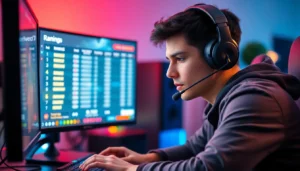In a world where headlines often feel like a circus, deep political cartoons cut through the noise with sharp wit and biting commentary. These illustrations don’t just make you chuckle; they make you think. With a single stroke of the pen, they tackle complex issues, turning the serious into the absurd and inviting viewers to ponder the deeper meanings behind the humor.
Imagine laughing while grappling with the very fabric of society—now that’s a talent! Political cartoons invite everyone to join the conversation, whether they’re seasoned activists or casual observers. They spark debate, challenge perspectives, and sometimes even inspire change. Dive into the world of deep political cartoons, where laughter meets insight and every image tells a story worth exploring.
Table of Contents
ToggleOverview Of Deep Political Cartoons
Deep political cartoons blend humor with serious commentary. They provoke thought and inspire conversations about pressing issues. Often, these illustrations capture the essence of political climates, making complex topics accessible. Observers can find satire that resonates on multiple levels throughout the content.
Artists utilize visual metaphors to address societal concerns, encouraging deeper reflection on prevailing norms. Through character depictions and exaggerated scenarios, political events become relatable. Well-crafted cartoons tap into cultural moments, enhancing their relevance and impact.
Viewers engage with these illustrations as they navigate various perspectives. Different interpretations arise, allowing for debates that foster understanding. Political cartoons often reflect current events, offering insights that news articles might overlook. Various platforms utilize them, from newspapers to social media, expanding their reach.
Many renowned artists have shaped this genre, each bringing unique styles and messages. Figures like Charles Addams or Thomas Nast have historically set the standard for critique. Contemporary artists continue this tradition, reflecting today’s issues through powerful imagery.
Deep political cartoons serve a vital role in society. They challenge audiences to reconsider viewpoints while providing relief through humor. Each illustration becomes a catalyst for dialogue, encourage people to think critically about their surroundings. Insights gained from these cartoons can inspire action, making them more than mere entertainment.
Characteristics Of Deep Political Cartoons
Deep political cartoons exhibit distinct features that contribute to their impactful nature. These characteristics reflect the unique blend of humor and serious commentary that provoke thought and discussions.
Satirical Elements
Satire stands at the core of deep political cartoons. Artists utilize exaggeration to highlight flaws in political systems and societal norms. Irony often enhances the commentary, showcasing contradictions present in current events. Additionally, parody may mimic recognizable figures, enabling audiences to connect familiar personas to complex issues. Through these satirical devices, cartoons create a space for reflection and critical conversations about governance and societal expectations. They reveal truths that might escape mainstream discourse, making them vital in shaping public opinion.
Artistic Techniques
Visual strategies define the artistic quality of deep political cartoons. Artists employ strong lines and vivid colors to capture attention instantly. Symbolism reinforces messages, with objects or characters representing broader concepts like justice, freedom, or corruption. Composition plays a crucial role, guiding viewers’ eyes toward significant details. Juxtaposition highlights contrasts between opposing ideas or figures, enhancing the underlying message. Through these artistic techniques, cartoons encapsulate complex sentiments, ensuring the commentary resonates with diverse audiences while encouraging analytical thought.
Historical Context
Deep political cartoons have evolved significantly, reflecting societal changes and political landscapes. They often serve as a mirror, revealing public sentiment and sparking discussions on pressing issues.
Evolution Through History
Political cartoons have roots that trace back to the 18th century, finding early forms in satirical publications. Artists like James Gillray and George Cruikshank paved the way for modern caricature by critiquing government actions and societal issues through their illustrations. The 20th century brought the rise of visual media, which transformed these cartoons into powerful forms of social commentary. The advent of mass communication broadened their reach, allowing artists to convey messages to larger audiences. Today, digital platforms maintain this tradition, enabling instantaneous sharing and reaction to political events across the globe.
Notable Artists
Several notable artists have shaped the landscape of deep political cartoons. Thomas Nast stands out for his impactful representations of social issues, particularly his campaigns against corruption in the late 19th century. His work established the framework for using satire to influence public opinion on matters like immigration and civil rights. Similarly, Herblock’s cartoons tackled issues such as McCarthyism and civil rights during the 20th century, driving conversations around justice and equality. Contemporary artists like Liza Donnelly and Keith Knight infuse modern themes into their work, addressing current events with humor and insight. Their contributions keep the genre relevant, engaging new generations in political discourse.
Impact On Society
Deep political cartoons significantly shape societal perspectives by challenging conventional views. These artistic expressions influence public opinion by connecting issues with humor, making complex ideas more relatable.
Influence On Public Opinion
Political cartoons often sway public opinion by highlighting societal flaws and injustices. Artists employ satire to reduce the distance between political figures and everyday life. For instance, when a cartoon characterizes a politician as incompetent, it can undermine that individual’s credibility. Such visual narratives remind audiences of critical issues, fostering a sense of urgency. The ability to address serious topics through humor engages viewers, prompting them to reconsider their beliefs about current events. Studies indicate that consistent exposure to these cartoons can alter perceptions and encourage activism, creating a more informed electorate.
Role In Political Discourse
Political cartoons play a vital role in contemporary political discourse by encouraging dialogue. Artists present visual critiques that prompt discussions over various political matters. Through powerful imagery, they stimulate debates that might otherwise remain dormant in public forums. Iconic figures like Thomas Nast historically paved the way for these contributions to discourse, focusing on corruption and civil rights. Current artists tackle modern themes, ensuring relevance to current events. Engaging with these cartoons invites audiences to reflect deeply on issues, inspiring them to articulate their opinions and potentially challenge the status quo.
Deep political cartoons remain a vital aspect of contemporary discourse. They challenge audiences to engage with pressing issues through humor and insight. By provoking thought and sparking debate these illustrations encourage viewers to reflect on their beliefs and the world around them.
As artists continue to blend satire with serious commentary they ensure that this genre evolves and remains relevant. The impact of these cartoons goes beyond mere entertainment; they serve as tools for social change and catalysts for meaningful conversations. In a rapidly changing political landscape their role in shaping perspectives and inspiring action is more important than ever.

